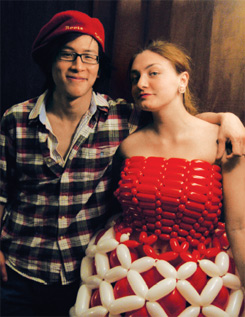Eye on the Quads
FOTA Op
The Festival of the Arts gives University artists the means to create, and the quads are their canvas.
The Reva and David Logan Center for Creative and Performing Arts won’t open until 2011, but that hasn’t stopped one student group from making sure the arts have a presence on campus—or all over it. Come Saturday, May 9, a section of flooring in Cobb will be covered in photography, a plasma screen in Reynolds Club will be the raw material for a new video installation, and Hutch Courtyard will be prepped for a fashion show, complete with a new sculpture piece centered around the existing fountain. These transformations and more will take place as part of the Festival of the Arts, commonly known as FOTA.
First held in 1955, the annual weeklong art carnival cultivates and encourages artistic pursuit at the University by turning the quads into a living museum of new work. Toward that end, FOTA looks for projects that will make an impression on campus, explains codirector and third-year Anastasia Barron. “The U of C is sort of notorious for being super-academic and not artsy at all, so we try to bring the artistic community to the attention of the school,” she says. “There is certainly a large, active, and talented group of students who are interested in the arts here, and FOTA gives them an opportunity to make art in a highly visible way.”
Before getting that opportunity, however, the artists must submit their ideas to the FOTA board, a registered student organization of about ten members, mostly undergraduate humanities majors, who decide which projects to include. (This year, 33 of 43 proposals made the cut.) FOTA also funds the projects, with a few caveats: no food (e.g., no subsidized pizza breaks for the artists), no tools (they’ll pay for paints but not brushes), and no services (you can’t hire someone to make the art for you). The project budget is a critical factor in the board’s decision—not so much its size, but its level of detail. “That’s one of the main criteria, just to see what kind of thought people have put into their project,” Barron explains. “How sure are we they can actually execute this and not just have an exciting idea?”
Also considered are possible safety or logistical problems. “A lot of it is whether the University will let us put things in trees and leave them there for a week,” says third-year Kate Dries, one of several FOTA curators who help the artists bring their work to fruition. “There are so many things we get that are really cool, but we have to say, I’m sorry, that’s a hazard.”
Safety shouldn’t be a problem with Displacement, a video installation by Natasha Hodnett that Dries is curating. Hodnett plans to shoot footage of Cobb Hall, the College’s oldest and one of its busiest buildings, and project the film in the modern, less-trafficked Hinds geophysical sciences lab—a comment on social and architectural differences in spaces. “The board liked that this idea uses the campus to its fullest capacity,” says Dries. “It is in a less visible place, but since that speaks to the point of the project, it seemed relevant.”
Exactly where in Hinds the footage gets shown
will be worked out between artist and curator
as the work progresses. Dries also is encouraging
Hodnett to publicize the installation, lest
it become a victim of its venue’s low profile.
“We’re kind of taskmasters,” Dries says of the
curators. “The point is to get artists to do things
they wouldn’t be able to do by themselves, and
that sometimes requires pushing them creatively.
Because it is better art when you put time into it.”
—Anthony Ruth, AB’03, AM’07

